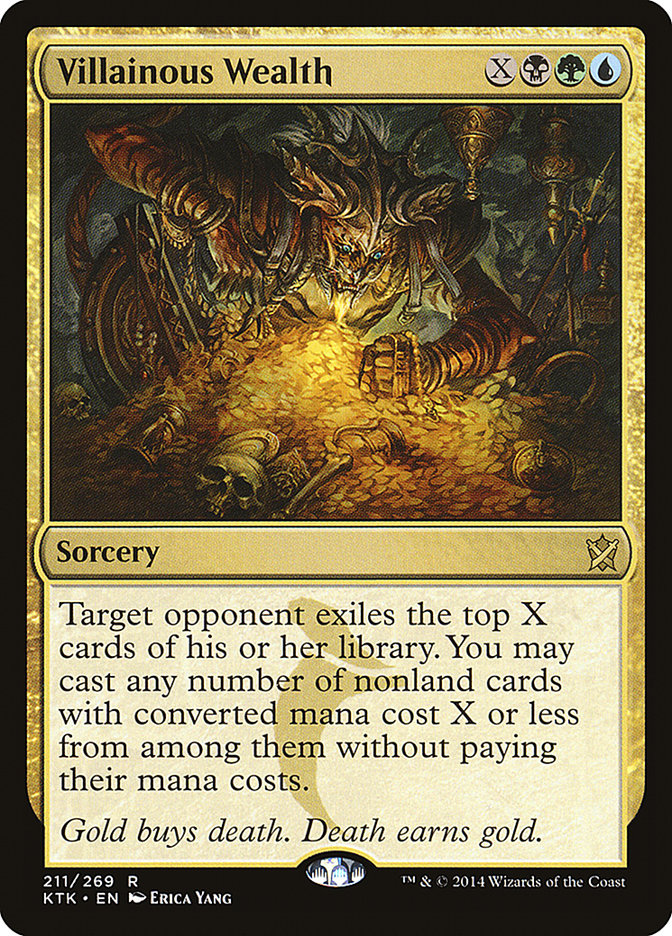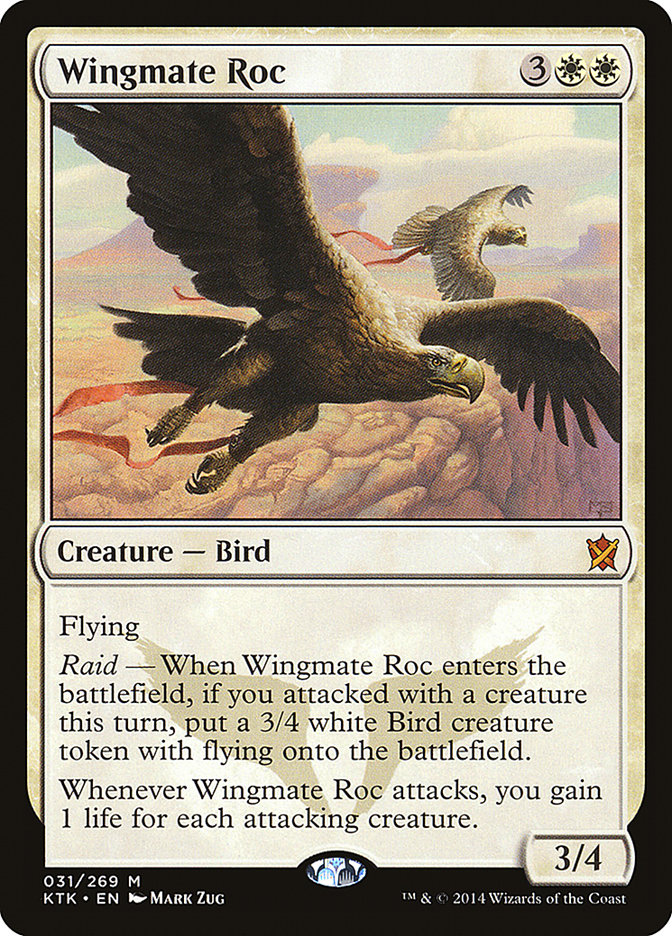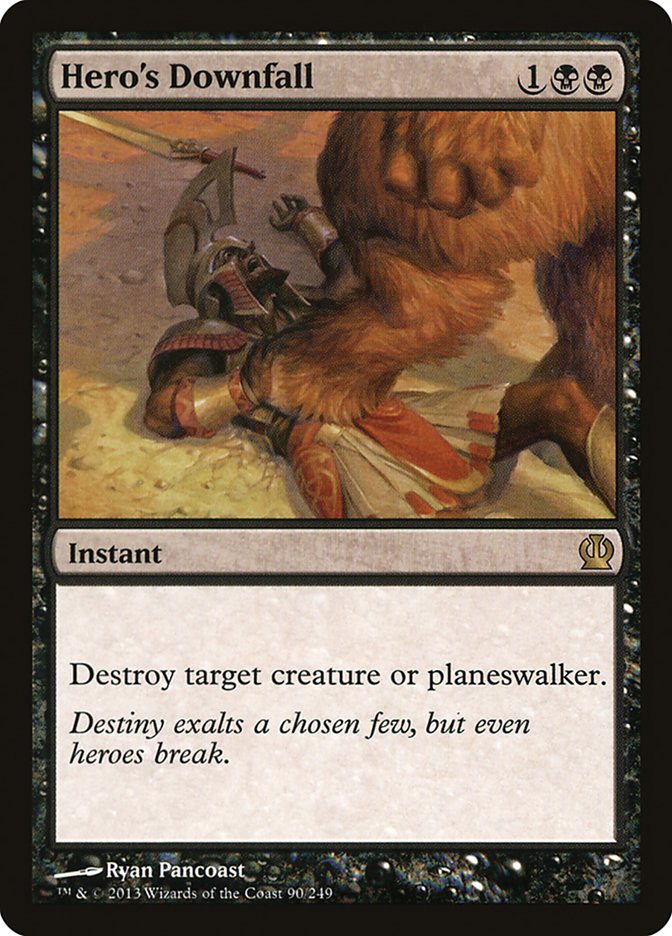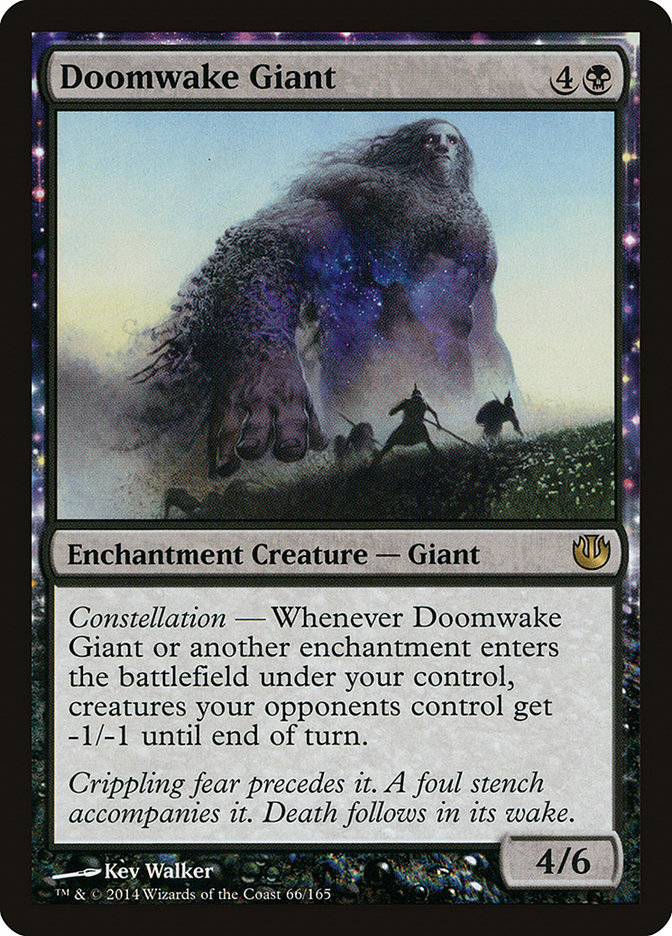The other week when I was watching the coverage for the World Championship, I realized something: my Villainous Wealth deck had serious game against nearly
all of these decks. I began to ponder what one of these all-time Magic greats could have done in that tournament if they had brought my Green Devotion
Villainous Wealth deck to the party?
But of course they wouldn’t-Villainous Wealth is still considered a joke card by the vast majority of the Magic community. This drives me nuts considering
I keep racking up win after win after win. Right now I’m 23-7-5 with the deck, and while most of these matches are FNMs, ten rounds of a highly competitive
SCG Open are in the mix. That’s a 67% win rate, and if you toss out the draws (a few intentional, a few unintentional) then it jumps up to 77% win rate.
Right now the metagame heavily favors midrange decks, and this deck has many of the same strengths as other midrange decks while also having the trump card
that beats the other midrange decks.
That trump card is Villainous Wealth.
I think most people blow this card off as a silly casual card and don’t stop to really think about what this card actually does. Talking with a friend he
said that he thought it was a win-more card. Yes, if you’re already ahead Villainous Wealth is a win-more card, but you can say that for the third and
fourth Siege Rhino you draw. But the card is fantastic at breaking open a stalemated game, something that happens quite a bit in the all-too-common
midrange versus midrange matchup. Typically those matches come down to eeking out incremental advantages through fortunate topdecks and being able to
capitalize on little mistakes, but resolving a Villainous Wealth typically blows the game wide open. I’ve also cast Villainous Wealth as a way to come back
and win games I was certain to otherwise lose.
The trick is to recognize that Villainous Wealth is a dual-engine card: not only is it generating card advantage, but it usually generates mana advantage
at the same time. Not only are you effectively drawing these cards, but you’re being given virtual mana to cast them too. Yes, you’re dumping a lot of mana
into casting Villainous Wealth, but when you add up the virtual mana you’re getting from casting the spells for free you can see you’re getting a lot more
than you’re putting into the spell.
To illustrate, let’s use the Sample Hand generator for the Top 4 World Championship from the mothership. We can use this to see the equivalent of a
Villainous Wealth where X=7, a total of 10 mana expended. This is a little bit of a stretch for the current configuration of my deck (where it tends to
fire off for X equals 4-6 typically), but it is not unusual, and we can make use of the website’s technology to mimic the effect of Villainous Wealth.
Yuuya Watanabe – Jeskai Tokens

Hordeling Outburst, Jeskai Ascendency, Jeskai Charm, Stoke the Flames (3 lands)
4-for-1 raw card advantage, we spent 10 mana and got back 13 mana, for a net mana gain of 3-that’s Black Lotus territory there. I wouldn’t consider Jeskai
Tokens to be the ideal matchup for Villainous Wealth, but for my build it’s not a terrible matchup either. One of the reasons I’ve been so happy with my
inclusion of Heir of the Wilds is its ability to interact early against these tempo-oriented decks that can otherwise push through a Sylvan Caryatid or
other potential early blockers; no matter how big you can grow Seeker of the Way, if he tussles with Heir of the Wilds, he dies. Sure, he bites it to
Lightning Strike, but if your opponent is burning removal on Heir, he’s going to have less options to deal with Reaper of the Wilds, Polukranos, or Arbor
Colossus.
Of course, living long enough to do a Villainous Wealth for seven is rather optimistic against Jeskai Tokens. Assume we needed to fire off Villainous
Wealth earlier, say X=5, how does it look then? We’d have gotten all the cards except for Stoke the Flames, so 3 cards and netting 1 mana. What’s
interesting to think about here is the timing: if you cast this before you attack, you could give your attackers +2/+2 from the Ascendancy triggers and
lifelink from the Jeskai Charm, which could pull your bacon out of the burn out range, not to mention leaving 3 blockers behind. If you cast this after you
attack, you can use the Ascendancy to untap your dudes for blocking and just use the Charm to remove one of their creatures from the battlefield (or just
dome them for four). Either way, you get to loot a few times too, so even if it’s not a huge swing on board, your position and hand (or future draws) are
bound to have improved.
Patrick Chapin – Abzan Midrange
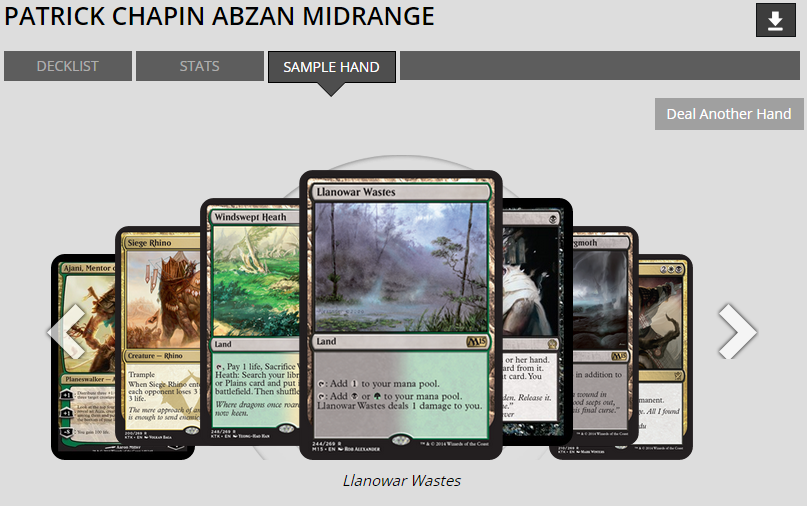
Ajani, Mentor of Heroes, Siege Rhino, Thoughtseize, Utter End (3 lands)
4-for-1 raw card advantage (assuming we can nab something with Thoughtseize), we spent 10 mana and got back 14 for a net gain of 4 mana. Ajani, of course,
can pay us back right away by digging for another card or boosting board presence. One of the strongest selling points for Villainous Wealth is that so
many decks are playing planeswalkers to generate extra card advantage over the course of several turns. If you manage to steal one while dramatically
impacting the board, you can really jump ahead.
I’ve come to expect good things from Villainous Wealth when playing against Abzan-let’s try another pull.
Patrick Chapin – Abzan Midrange
Wingmate Roc, Hero’s Downfall, Hero’s Downfall, Abzan Charm, Hero’s Downfall (2 lands)
5-for-1 raw card advantage (assuming targets for all the copies of Hero’s Downfall), though if we use the Charm to draw, that would be 6-for-1 card
advantage (not including a raid trigger on the Roc), we spent 10 mana and got back 17 for a whopping net gain of 7 mana! This batch illustrates why it’s
important to consider what cards you might get when you fire off Villainous Wealth. If you know your opponent is playing Wingmate Roc (gee, thanks Courser
of Kruphix!), it might behoove you to get in an attack before you cast Villainous Wealth and get that raid trigger.
Kentaro Yamamoto – Sidisi Whip
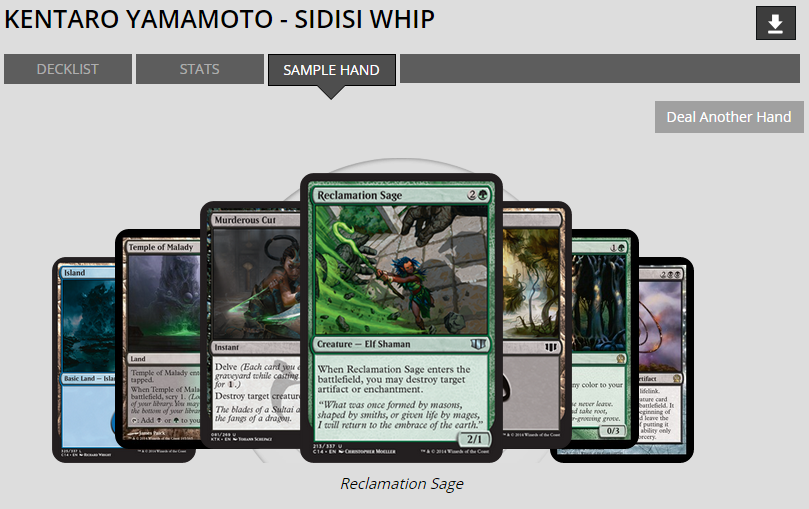
Murderous Cut, Reclamation Sage, Sylvan Caryatid, Whip of Erebos (3 lands)
4-for-1 raw card advantage, we spent 10 mana and got back 14 mana. This Villainous Wealth would be particularly sweet because you nabbed one of the
namesake Whips while also getting a Sage that could destroy an opponent’s Whip. Also our own deck likely has a fair number of creatures capable of being
Whipped back into play for value; my Villainous Wealth deck generates a ton of mana so the activation cost of the Whip is easily paid for.
I’ve also come to expect good things from Villainous Wealth when playing against Sidisi Whip-let’s try another pull.
Kentaro Yamamoto – Sidisi Whip
Thoughtseize, Satyr Wayfinder, Murderous Cut, Hero’s Downfall (3 lands)
4-for-1 raw card advantage, we spent 10 mana and got back just 11 mana. Not the most impressive, but you take out the two biggest threats while nabbing
another threat they had in hand, assuming you’ve got any board presence at all you’ve now jumped to a commanding lead.
Alright let’s pull from the World Champion’s deck…
Shahar Shenhar – Sidisi Whip

Hornet Queen, Sylvan Caryatid, Sylvan Caryatid, Thoughtseize (3 lands)
4-for-1 raw card advantage, we spent 10 mana and got back 12 mana. Hornet Queen turns this from being totally underwhelming into being totally awesome.
Getting two additional sources of mana makes any monstrous activations or another Wealth that much better. What’s interesting to consider is that any X
value under seven would be extremely underwhelming, though getting two potential blockers and mana-makers isn’t totally without value.
Let’s spin it again…
Shahar Shenhar – Sidisi Whip
Sidisi, Brood Tyrant; Murderous Cut, Doomwake Giant, Doomwake Giant (3 lands)
Okay, now we’re talking! 4-for-1 raw card advantage, we spent 10 mana and got back a whopping 18 mana. Two Doomwake Giants, the Cut, and a Sidisi should do
wonders for our board presence.
I hope that these examples helped illuminate the actual power of Villainous Wealth. It’s not a joke card, and it’s not just a casual card. Maybe it’s the
fact that you’re drawing off someone else’s deck that makes this feel like a fringe card, but if you assume that most of your opponents in a tournament are
playing good cards in their deck, then you’ll be drawing and playing good cards when you cast Villainous Wealth. You’ll be generating card advantage, mana
advantage, and most likely board advantage each time you cast it. The trick, of course, is to have Villainous Wealth in a deck that is built to take
advantage of it, and I feel that my build is the best to do that. First and foremost, you need a lot of mana, and nothing in Standard gives you the
potential for insane mana like Nykthos, Shrine to Nyx. Using Nykthos for mass mana also costs us no “action” card slots, which helps make my version of
Villainous Wealth less filled with “air” than those that use enchantments for mana ramp. To fuel Nykthos you need devotion, so you need to fill out your
deck with durable permanents. Lucky for us, quality creature removal right now is relatively expensive and hard to come by, so if we fill out our deck with
good green creatures we can usually keep ahead of our opponent’s ability to stunt our devotion with creature removal. Keep this in mind if you’re building
your own version of the deck: each card you put in the deck that doesn’t fuel devotion makes Nykthos a little worse. Also, think twice about cutting
threats out of your deck: again, removal is at a premium, so the more threats you play the more you strain their ability to control your board. Each time
they burn a removal spell on one of your threats it makes your subsequent threats better.

I like to think about my deck in this metagame through a Kill Bill lens. All the midrange decks are the Deadly Viper Assassination squad:
· Green/Black Constellation is Vernita Green/Copperhead
· Abzan Midrange is O-Ren Ishii/Cottonmouth
· Sidisi Whip is Elle Driver/California Mountain Snake
· Mardu Midrange is Bill/Snake Charmer
· Temur Monsters is Bud/Sidewinder

Green Devotion is Beatrix Kiddo/Black Mamba, who gets stomped by the other Midrange Assassination squad until she gets pissed off and acquires her Hattori
Hanzo sword (Villainous Wealth) that gives her the edge she needs to kick the other Midrange deck’s asses. Beating them is not easy, or pretty, but in the
end she is victorious. You know when Beatrix Kiddo beats O-Ren’s Crazy 88s, and afterwards she claims all the severed limbs as belonging to her? Those
severed limbs are the cards you get from your opponents when you swing the Villainous Wealth sword: “they belong to me now.” The thing to remember
is that a Hattori Hanzo sword alone isn’t going to win the games-you need the full range of assassination skills (Nykthos big mana, enough threats to
overload removal) to go with the Villainous Wealth sword to emerge victorious.

For those who are curious, here’s the current incarnation of the deck:
Creatures (27)
- 1 Hornet Queen
- 4 Polukranos, World Eater
- 4 Sylvan Caryatid
- 4 Arbor Colossus
- 2 Reaper of the Wilds
- 4 Voyaging Satyr
- 4 Courser of Kruphix
- 4 Heir of the Wilds
Lands (25)
Spells (8)

I’m getting pretty darn close to an optimal maindeck configuration: instead of running a 2/2 split on Elvish Mystic and Voyaging Satyr, I’ve decided to
drop the Mystics and run the Satyrs. With so many 1/1 tokens running around I think it only makes sense to run the Satyrs since they can block and kill a
token and survive (minus all the Jeskai Ascendancy tricks). Yes, I hate giving up the occasional turn 2 Courser of Kruphix, but I think having the extra
1/2 blockers is more valuable towards the goal of buying enough time. The other change is cutting the Rakshasa Deathdealer for a land. First off, the
Deathdealers were underperforming for me; even with the heavier emphasis of black in the deck, I still found too often I wasn’t having the mana to do what
I wanted to do with them. Also, the only time this deck really falters is when I stumble on mana early so I think going up to 25 lands makes sense. Courser
of Kruphix helps a land-heavy deck draw more gas than it should, and of course, the more land you have in play the better Villainous Wealth becomes.
The sideboard has been tweaked to better combat the Jeskai Ascendancy and Whip decks that are so prevalent out there.
So what do you think-have I sold you on giving Villainous Wealth a try? If not, why not? And if you have given it a try, what are your impressions and
observations?
Villainous Wealth In Commander
Of course, when Villainous Wealth was first spoiled, a lot of Commander fans immediately recognized it as the type of card that will really shine in a
format of big spells and big mana. Since I’ve written a bunch about Villainous Wealth in Standard and since I also write about Commander, I’ve had a lot of
people ask me about the card in multiplayer. Yes, you can really set up your deck to generate a large amount of mana – even “arbitrarily large” –
relatively easy, and you can certainly stuff your deck with tutors to help you find Villainous Wealth when you’re ready to play every non-land card from
someone’s library.
But what happens when you pass the turn and it’s their draw step? They lose from decking and all the permanents you acquired from them go POOF! There’s
actually some finesse involved if you really want to maximize Villainous Wealth in multiplayer-whoever you victimize with Villainous Wealth now needs to
remain in the game long enough for you to beat everyone else with all those extra cards.
With that in mind, here’s a Villainous Wealth-centric deck I built to take on high-powered (but not necessarily fast-combo) tables:
Creatures (28)
- 1 Birds of Paradise
- 1 Seedborn Muse
- 1 Eternal Witness
- 1 Composite Golem
- 1 Viridian Joiner
- 1 Palinchron
- 1 Citanul Hierophants
- 1 Drift of Phantasms
- 1 Junktroller
- 1 Loaming Shaman
- 1 Body Double
- 1 Riftsweeper
- 1 Reaper King
- 1 Scuttlemutt
- 1 Bloom Tender
- 1 Noble Hierarch
- 1 Abyssal Persecutor
- 1 Necrotic Ooze
- 1 Spellskite
- 1 Phyrexian Metamorph
- 1 Rune-Scarred Demon
- 1 Deadeye Navigator
- 1 Progenitor Mimic
- 1 Sylvan Caryatid
- 1 Prophet of Kruphix
- 1 Kiora's Follower
- 1 Disciple of Deceit
- 1 Clever Impersonator
Lands (38)
- 5 Forest
- 1 Plains
- 1 Gaea's Cradle
- 1 Reflecting Pool
- 1 Volrath's Stronghold
- 3 Swamp
- 1 Mountain
- 3 Island
- 1 Underground Sea
- 1 Tropical Island
- 1 Bayou
- 1 Phyrexian Tower
- 1 Overgrown Tomb
- 1 Watery Grave
- 1 Breeding Pool
- 1 Tolaria West
- 1 Exotic Orchard
- 1 Rupture Spire
- 1 Drowned Catacomb
- 1 Command Tower
- 1 Hinterland Harbor
- 1 Woodland Cemetery
- 1 Cavern of Souls
- 1 Transguild Promenade
- 1 Thespian's Stage
- 1 Temple of Deceit
- 1 Temple of Mystery
- 1 Opal Palace
- 1 Temple of Malady
- 1 Opulent Palace
Spells (34)
- 1 Vampiric Tutor
- 1 Mystical Tutor
- 1 Grim Monolith
- 1 Intruder Alarm
- 1 Swords to Plowshares
- 1 Sylvan Library
- 1 Sol Ring
- 1 Mind Twist
- 1 Demonic Tutor
- 1 Power Artifact
- 1 Fellwar Stone
- 1 Diabolic Tutor
- 1 Conspiracy
- 1 Darksteel Ingot
- 1 Reito Lantern
- 1 Insidious Dreams
- 1 Mirari's Wake
- 1 Staff of Domination
- 1 Skullclamp
- 1 Long-Term Plans
- 1 Defense of the Heart
- 1 Carpet of Flowers
- 1 Claws of Gix
- 1 Perplex
- 1 Demonic Collusion
- 1 Sprout Swarm
- 1 Mana Reflection
- 1 Nim Deathmantle
- 1 Swan Song
- 1 Retraction Helix
- 1 Aetherspouts
- 1 Villainous Wealth
- 1 Jeskai Ascendancy
- 1 Commander's Sphere

Even though this is primarily a Sultai deck, I chose Reaper King as my commander to give me access to a few spells I wanted in the deck that I’d otherwise
not be able to play; plus it’s feasible to cast Reaper King even if you only have green, blue, and black mana. And if the Villainous Wealth plan doesn’t
seem to be happening, going for Conspiracy on scarecrows seems like great fun.
For big mana, I’ve got quite a few angles. First are regular mana creatures like Birds of Paradise and Bloom Tender plus Jeskai Ascendancy; each
non-creature spell you cast that costs less than the mana you can tap for with these creatures nets you mana. You can do the same with Intruder Alarm for
creature spells. The card I’ve got to combo with either engine is Sprout Swarm. For arbitrarily large amounts of mana I’ve got Palinchron and either
Deadeye Navigator, Mana Reflection, or Mirari’s Wake; Grim Monolith and Power Artifact; and last but not least, Composite Golem plus Nim Deathmantle.
Once you’ve got the big mana, now we’ve got to find the big spell! Vampiric Tutor, Mystical Tutor, Demonic Tutor, Disciple of Deceit, Drift of Phantasms,
Long-Term Plans, Perplex, Diabolic Tutor, Insidious Dreams, and Rune-Scarred Demon give you multiple ways of getting your Villain on. I even included
Riftsweeper in case someone is rude enough to knock it out of your hand with Wheel of Fortune and then Tormod’s Crypt your graveyard.
Now for cards to keep your first victim alive long enough to kill everyone else with all those extra cards… I’ve included Reito Lantern and Junktroller to
feed them cards (preferably lands) from their graveyard, but probably the best and most villainous card is Abyssal Persecutor. With that demon in play you
can drain their libraries dry and leave them twisting in the wind like spectral husks, unable to die until you knock off the Persecutor with Phyrexian
Tower or Claws of Gix.
Yes, this is quite a vicious and cruel build, but I wanted to illustrate how to build a Commander deck with a laser focus on finding, casting, and
successfully using Villainous Wealth. You can always just toss Villainous Wealth into any Sultai deck that has at least some amount of mana ramp and it’s
going to do fun things… but I didn’t figure you needed me to show you that!
New to Commander?
If you’re just curious about the format, building your first deck, or trying to take your Commander deck up a notch, here are some handy links:
-
Commander Primer Part 1
(Why play Commander? Rules Overview, Picking your Commander) -
Commander Primer Part 2
(Mana Requirements, Randomness, Card Advantage) -
Commander Primer Part 3
(Power vs. Synergy, Griefing, Staples, Building a Doran Deck) -
Commander Starter Kits 1
(kick start your allied two-color decks for $25) -
Commander Starter Kits 2
(kick start your enemy two-color decks for $25) -
Commander Starter Kits 3
(kick start your shard three-color decks for $25)
Commander write-ups I’ve done
(and links to decklists):
• Feldon of the Third Path (She Will Come Back to Me)
• Sidisi, Brood Tyrant (Calling Up Ghouls with Sidisi)
• Zurgo Helmsmasher (Two Times the Smashing)
• Anafenza, the Foremost (Anafenza and Your Restless Dead)
• Narset, Enlightened Master (The New Voltron Overlord)
• Surrak Dragonclaw (The Art of Punching Bears)
• Avacyn, Guardian Angel; Ob Nixilis, Unshackled; Sliver Hivelord (Commander Catchup, Part 3)
• Keranos, God of Storms; Marchesa, the Black Rose; Muzzio, Visonary Architect (Commander Catchup, Part 2)
• Athreos, God of Passage; Kruphix, God of Horizons; Iroas, God of Victory (Commander Catchup, Journey into Nyx Edition)
• Kurkesh, Onakke Ancient (Ghost in the Machines)
• Jalira, Master Polymorphist (JaliraPOW!)
• Mishra, Artificer Prodigy (Possibility Storm Shenanigans)
• Yisan, the Wanderer Bard (All-in Yisan)
• Selvala, Explorer Returned (Everyone Draws Lots!)
• Grenzo, Dungeon Warden (Cleaning Out the Cellar)
• Karona, False God (God Pack)
• Doran, the Siege Tower (All My Faves in One Deck!)
• Karador, Ghost Chieftain (my Magic Online deck)
• Karador, Ghost Chieftain (Shadowborn Apostles & Demons)
• King Macar, the Gold-Cursed (GREED!)
• Niv-Mizzet, the Firemind ( Chuck’s somewhat vicious deck)
• Roon of the Hidden Realm (Mean Roon)
• Skeleton Ship (Fun with -1/-1 counters)
• Vorel of the Hull Clade (Never Trust the Simic)
Previous Commander decks currently on hiatus
:
• Anax and Cymede (Heroic Co-Commanders)
• Aurelia, the Warleader ( plus Hellkite Tyrant shenanigans)
• Borborygmos Enraged (69 land deck)
• Bruna, Light of Alabaster (Aura-centric Voltron)
• Damia, Sage of Stone ( Ice Cauldron shenanigans)
• Emmara Tandris (No Damage Tokens)
• Gahiji, Honored One (Enchantment Ga-hijinks)
• Geist of Saint Traft (Voltron-ish)
• Ghave, Guru of Spores ( Melira Combo)
• Glissa Sunseeker (death to artifacts!)
• Glissa, the Traitor ( undying artifacts!)
• Grimgrin, Corpse-Born (Necrotic Ooze Combo)
• Jeleva, Nephalia’s Scourge ( Suspension of Disbelief)
• Johan (Cat Breath of the Infinite)
• Jor Kadeen, the Prevailer (replacing Brion Stoutarm in Mo’ Myrs)
• Karona, False God (Vows of the False God)
• Lord of Tresserhorn (ZOMBIES!)
• Marath, Will of the Wild ( Wild About +1/+1 Counters)
• Melira, Sylvok Outcast ( combo killa)
• Mirko Vosk, Mind Drinker ( Outside My Comfort Zone with Milling
)
• Nefarox, Overlord of Grixis (evil and Spike-ish)
• Nicol Bolas (Kicking it Old School)
• Nylea, God of the Hunt ( Devoted to Green)
• Oloro, Ageless Ascetic (Life Gain)
• Oona, Queen of the Fae (by reader request)
• Phage the Untouchable ( actually casting Phage from Command Zone!)
• Polukranos, World Eater (Monstrous!)
-
• Progenitus (
Fist of Suns and Bringers
)
• Reaper King (Taking Advantage of the new Legend Rules)
• Riku of Two Reflections (
steal all permanents with Deadeye Navigator + Zealous Conscripts
)
• Roon of the Hidden Realm ( Strolling Through Value Town)
• Ruhan of the Fomori (lots of equipment and infinite attack steps)
• Savra, Queen of the Golgari ( Demons)
• Shattergang Brothers (Breaking Boards)
• Sigarda, Host of Herons ( Equipment-centric Voltron)
• Skullbriar, the Walking Grave ( how big can it get?)
• Sliver Overlord (Featuring the new M14 Slivers!)
• Thelon of Havenwood ( Campfire Spores)
• Varolz, the Scar-Striped (scavenging goodness)
• Vorosh, the Hunter ( proliferaTION)


